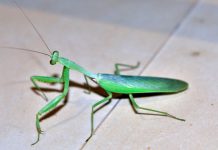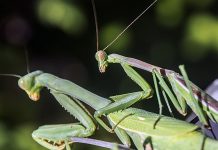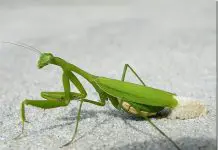A praying mantis female deposits many eggs shortly after her mating. The eggs she lays may only be a handful or hundreds (300-400). The mother mantis covers her eggs with a thick substance that hardens rapidly to a consistency similar in texture to polystyrene using her special accessory glands. This egg case, also known as an “ootheca”, is called a ootheca. After mating once, several oothecae may be produced by a single female mantis.

Praying mantises often lay their eggs in autumn or late summer. The young then develop within the ootheca throughout the winter. The foamy egg case protects offspring from cold and predators. Tiny mantis-nymphs hatch while their eggs are still inside the eggcase.
The time it takes for the nymphs to emerge from the mouth of the ootheca depends on their environment and species. The young praying mantises are ready to hunt small invertebrates and will emerge from their protective foam case around spring or summer. They start to disperse immediately in search of food.
How to Tell If Praying Mantis Eggs have Hatched?
Praying Mantis eggs usually takes 42 to 56 days at 65-75°F daytime and 45° at night to hatch. It is rare that an egg case does not hatch. Please be patient if they haven’t already hatched.
If you wish to accelerate the hatching process, we recommend placing the egg cases (still in the bags) on top a refrigerator or another place that is warm but not too hot. You should not put them on the windowsill. Temperatures fluctuate too much.
Tip: Tiny praying nymphs may emerge from the egg shell’s narrow openings. It is impossible to tell whether the egg cases have actually been hatched unless you are able to find the tiny nymphs (1/8 inch).
What to do If you Discover the Case in your Yard?
If you discover them on your garden stakes, or other garden objects after clearing up your garden’s mess, be sure to leave them near your plants. The wooden stakes will provide shelter from predators and small insects so they can hatch quickly.
References and Further Reading
“Ootheca.” Amateur Entomologists’ Society, www.amentsoc.org. Accessed 15 Sept. 2014.
“Praying Mantid Care Sheet.” Amateur Entomologists’ Society, www.amentsoc.org. Accessed 15 Sept. 2014.





















